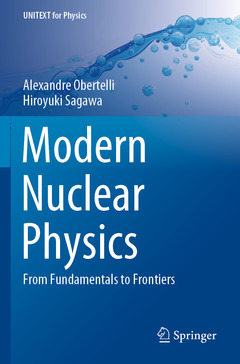Description
Modern Nuclear Physics, 1st ed. 2021
From Fundamentals to Frontiers
UNITEXT for Physics Series
Language: English
Subjects for Modern Nuclear Physics:
Keywords
Theories, Phenomena and Observables of Nuclear Structure, Superheavy Elements, Unstable Nuclei, Halo and Skin Nuclei, Di-neutron Correlations and Superfluidity, Yukawa Force, Lattice Quantum Chromodynamcis, Chiral Effective Theory, Astronuclear Physics, Celestial Observables and Neutron Stars, Quarks, Gluons and CMK Matrix in Standard Model, Nuclear Reaction, Nuclear Fusion and Nuclear Fission, Lattice OCD, Open shell nuclei
Publication date: 09-2022
727 p. · 15.5x23.5 cm · Paperback
Publication date: 09-2021
Support: Print on demand
Description
/li>Contents
/li>Biography
/li>Comment
/li>
Tentative Table of Contents [ asterisk (*) for graduate level]
1. Concepts of quantum mechanics from the nuclear viewpoint
1.1 Genesis of quantum physics
1.2 Spin and Isospin
1.3 Quantum entanglement
1.4 Schrödinger equation
1.5 Quantum Tunneling in one dimension
1.6 Uncertainty relation
1.7 Symmetries and symmetry breaking
1.8 Dirac equation *)
1.9 Lagrangian and Path integral *)
1.10 Second quantization *)
2. Nuclear forces
2.1 Fundamental interactions
2.2 Nuclear force and symmetry constraints
2.3 Meson theory of nucleon-nucleon (NN) interaction
2.4 Phase shifts and nuclear potentials
2.5 Three-body forces
2.6 Chiral Effective Field Theory (ChEFT)*)
3. Nuclear Structure theory
3.0 Bird’s eye view of nuclear models
3.1 Nuclear mean field
3.2 Random phase approximation
3.2 Energy density f
3.2.1 Pairing interactions and BCS/Bogolyubov approximation
3.3 Beyond the mean field approaches*)
3.3.1 Generator coordinate method (GCM)
3.3.2 Anti-symmetrized molecular dynamics (AMD)
3.4 The Monte Carlo shell models*)
3.5 Ab-initio approaches*)
3.5.1 No core shell model (NCSM)
3.5.2 Variational (VMC) and Green’s function Monte Carlo (GFMC) approaches
3.5.3 Fermionic molecular dynamics (FMD)
4. Nuclear Structure phenomena and observables
4.1 Spectroscopic observables for shell structure
4.2 Collective oscillations
4.3 Short-range correlations
4.4 Superheavy elements
4.5 Hypernuclei
5. Radioactive ion beam physics
5.1 Radioactive ion beam accelerators
5.2 In-beam gamma-ray spectroscopy and inverse kinematics
5.3 Neutron-rich nuclei –halo and skin
5.4 Evolutio
5.5 Di-neutron correlations and nuclear superfluidity *)
5.6 Clusters in nuclei *)
6. Deformation and Rotation
6.1 Deformation of Molecules and Nuclei
6.2 Nuclear deformation and observables
6.3 Microscopic origin for nuclear deformations and prolate dominance
6.4 Measuring shapes
6.4.1 Hyperfine atomic structure from laser spectroscopy
6.4.2 Magnetic and Quadrupole Nuclear Resonance
6.4.3 Coulomb excitation
6.5 Shape and shape coexistence*)
6.6 Superdeformation and Hyperdeformation*)
6.7 Advances in gamma spectroscopy*)
7. Nuclear reactions
7.1 Overview of reaction mechanics
7.2 Elastic scattering
7.3 Direct reactions
7.1.1 Spectroscopic factors
7.1.2 Transfer rections
7.1.3 Quasifree scatterin
7.1.4 Heavy-ion induced nucleon removal
7.4 Nuclear fusion
7.4.1 Solar energies , and p-p chain reaction and CNO cycle
7.4.2 Magnetic confinement and the ITER project *)
7.4.3 Inertial confinement *)
7.5 Nuclear fission
7.5.1 Macroscopic models
7.5.2 Microscopic models *)
7.5.3 Principle of a nuclear power plant *)
8. Celestial observables and terrestrial experiments
8.1 Nuclear Equation-of-States constrained by terrestrial observables
8.2 Neutron stars
8.3 Nucleosynthesis
8.4 Supernovae explosion *)
9. Nuclear physics and the standard model of elementary particle
9.1 Standard model
9.2 Lattice Quantum Chromodynamics for Nuclei *)
9.3 CKM matrix and superallowe
9.4 Neutrino oscillations and search for a 4 th neutrino*)
9.5 Double beta decay and neutrino mass*)
9.6 Appendix for LQCD*)
Alexandre Obertelli received his Ph.D. degree from the University of Paris XI, France, in 2005. He is Alexander-von-Humboldt professor at the Technical University of Darmstadt, Germany. He carries experiments on the structure of radioactive nuclei at the Radioactive Isotope Beam Factory of RIKEN, Japan, at CERN, Switzerland, and GSI/FAIR, Germany.
Hiroyuki Sagawa is a senior visiting scientist at RIKEN, Japan, and a professor emeritus at the University of Aizu, Japan. He obtained his Ph.D. degree from Tohoku University in 1975. After he worked at the Niels Bohr Institute in Denmark, Paris-Sud University in France, and the National Superconducting Cyclotron Laboratory in USA, he was appointed as a research associate at the University of Tokyo and then moved to the University of Aizu as a full professor. His work mainly involves nuclear structure and reaction theory, and he also actively contributes to book publishing programs.
Teaches students the fundamentals necessary to understand modern nuclear physics
Describes concisely interdisciplinary connections with elementary particle physics and astrophysics
Covers various cutting-edge topics in nuclear physics, such as exotic structure of unstable nuclei, effective field theory, and lattice QCD on many body problems in nuclei and technologies of modern experimental facilities
Includes careful mathematical derivations, illustrations, and exercises with complete solutions




